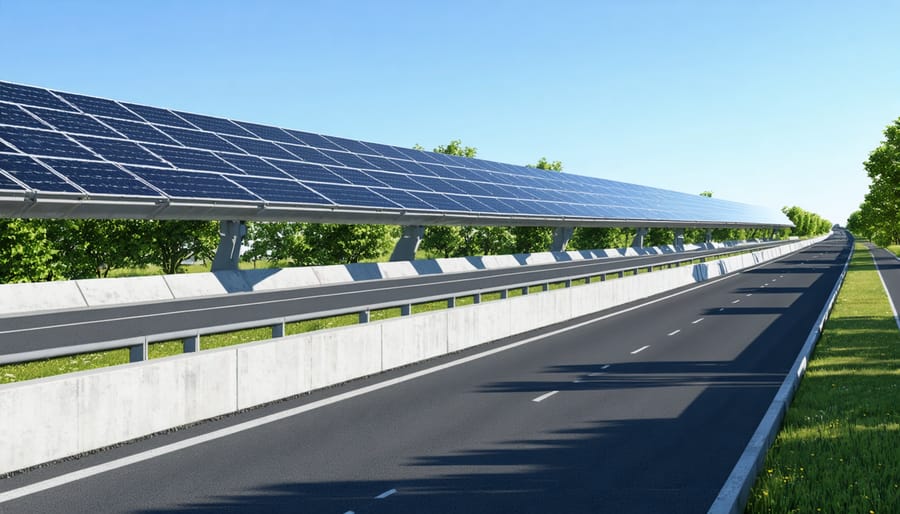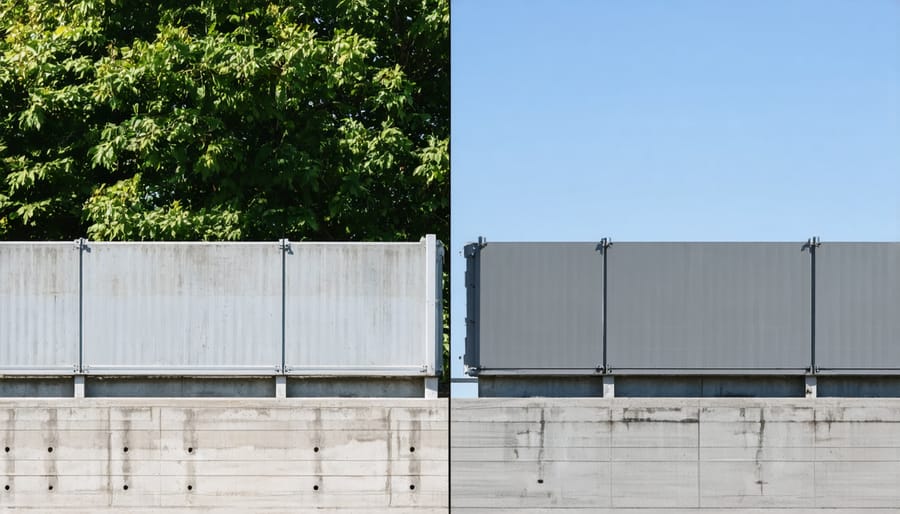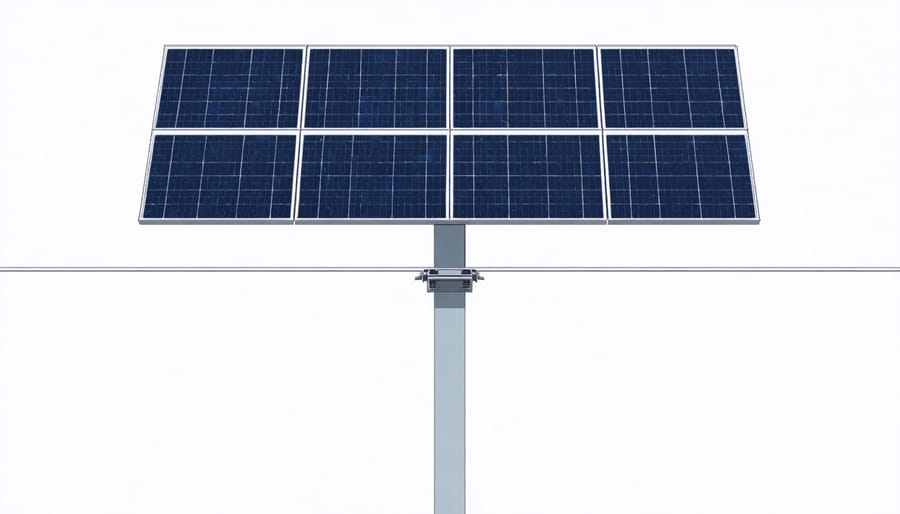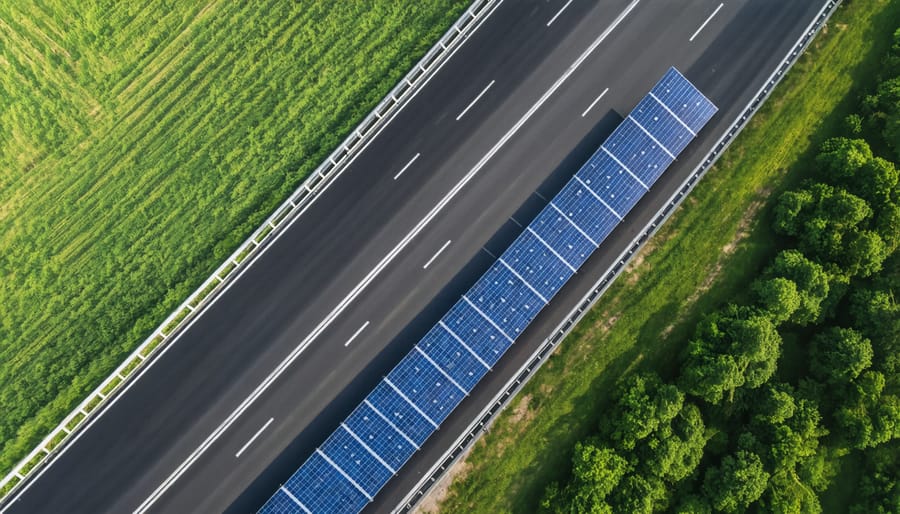Solar Noise Barriers: How Highways Are Becoming Clean Energy Powerhouses

Modern noise barriers along European highways are evolving from simple acoustic shields into sophisticated multifunctional infrastructure, revolutionizing how we approach sustainable urban development. These innovative barriers not only protect nearby communities from traffic noise but increasingly integrate solar panels, transforming previously passive structures into active energy generators.
As cities expand and traffic volumes surge, the latest generation of highway noise barriers demonstrates remarkable engineering ingenuity by combining sound absorption technology with photovoltaic capabilities. These dual-purpose installations typically reduce noise levels by 5-10 decibels while generating significant clean energy—up to 50 kWh per square meter annually in optimal conditions.
The Netherlands and Germany lead this transformation, showcasing how traditional concrete and acrylic barriers can be reimagined as solar-acoustic walls that serve multiple environmental objectives. These installations represent a critical intersection of urban planning, renewable energy, and public health protection, offering a compelling solution for densely populated areas where both noise pollution and energy demands present ongoing challenges.
For infrastructure planners and local authorities, these solar noise barriers represent an intelligent investment in sustainable urban development, addressing both immediate community needs and long-term environmental goals within a single infrastructure solution.
The Evolution of Highway Noise Barriers
Traditional Noise Barriers vs. Solar-Integrated Solutions
Traditional highway noise barriers, typically constructed from concrete, wood, or metal, have served their primary purpose of sound reduction effectively for decades. However, modern solar-integrated barriers represent a significant leap forward in infrastructure innovation. These advanced solutions combine proven noise reduction capabilities with renewable energy generation, offering a dual-purpose approach to highway infrastructure.
While conventional barriers achieve noise reduction levels of 5-10 decibels, solar-integrated versions maintain this acoustic performance while generating clean electricity. The integration of photovoltaic panels doesn’t compromise the barrier’s primary function but adds substantial value through energy production. This innovative approach transforms what was once a single-purpose structure into a smart infrastructure asset.
The initial investment for solar noise barriers is typically higher than traditional options. However, the energy generation capability creates a new revenue stream that can offset installation costs over time. Modern designs also incorporate enhanced aesthetic elements, with sleek solar panels replacing conventional concrete walls, contributing to a more visually appealing highway environment. This evolution in barrier technology exemplifies how infrastructure can adapt to meet both environmental challenges and energy needs simultaneously.

European Innovation in Highway Infrastructure
Europe has emerged as a global leader in innovative highway infrastructure, particularly in developing advanced solar noise barrier technology that is revolutionizing European highways. Countries like the Netherlands, Germany, and Switzerland have pioneered the integration of photovoltaic panels into noise barriers, creating dual-purpose installations that both protect communities from traffic noise and generate clean energy.
Notable projects include the Solar Highways initiative in the Netherlands, which has successfully implemented over 400 meters of solar noise barriers along the A50 motorway. These installations generate enough electricity to power approximately 600 households while maintaining optimal noise reduction properties.
Swiss engineers have developed specialized coating technologies that enhance both solar absorption and acoustic performance, while German research institutions have perfected modular designs that simplify installation and maintenance. These innovations have set new standards for sustainable infrastructure, combining environmental protection with renewable energy generation in a space-efficient solution that maximizes the use of existing highway corridors.
Technical Components and Design
Solar Panel Integration Methods
Solar noise barriers integrate photovoltaic technology through several innovative methods, each designed to maximize both sound reduction and energy generation. The most common approach involves mounting bifacial solar panels vertically along the barrier structure, allowing them to capture sunlight from both sides while maintaining optimal noise protection. This design particularly suits regions with high Europe’s solar potential and busy highway networks.
The integration process typically employs one of three main systems: direct mounting, modular cassette systems, or integrated panel designs. Direct mounting utilizes specialized brackets that secure panels to existing noise barrier frameworks, offering a cost-effective retrofit solution. Modular cassette systems feature pre-assembled units that combine both noise absorption materials and solar panels, enabling quick installation and easier maintenance.
Integrated panel designs represent the most advanced approach, where solar cells are embedded directly within transparent or semi-transparent noise barrier materials. These solutions often utilize specialized glass that combines sound-dampening properties with photovoltaic capabilities, creating a seamless aesthetic while serving dual purposes.
The mounting systems must meet strict safety standards for highway infrastructure while ensuring optimal panel angles for solar generation. Engineers typically incorporate flexible mounting solutions that allow for thermal expansion and wind load management, essential for long-term structural integrity and performance reliability.

Acoustic Performance and Energy Generation
Modern highway noise barriers are evolving beyond their primary function of sound reduction to become innovative energy-generating assets. These dual-purpose structures typically achieve noise reduction levels of 5 to 10 decibels, which translates to a 50% decrease in perceived traffic noise for nearby residents and businesses. When integrated with photovoltaic technology, these barriers can generate between 15 to 30 kilowatt-hours of electricity per square metre annually, depending on their orientation and local solar conditions.
The acoustic performance remains uncompromised by the solar integration, as manufacturers employ specialized materials and designs that maintain optimal sound absorption and reflection properties. The vertical positioning of these barriers, while not ideal for maximum solar energy capture, still provides significant power generation potential across the extensive network of European highways.
Recent innovations include smart acoustic panels that adapt to traffic patterns and weather conditions, maximising both noise reduction and energy generation efficiency. These systems can automatically adjust their angle slightly throughout the day to optimise solar collection while maintaining effective sound barriers. Additionally, the integration of bifacial solar panels allows for energy capture from both direct sunlight and reflected light, increasing overall generation capacity.
The combined effectiveness of these systems makes them particularly attractive for urban and suburban areas where land is at a premium and multiple environmental challenges need addressing simultaneously.
Environmental and Economic Benefits
Energy Production Metrics
Solar noise barriers demonstrate impressive energy production capabilities while serving their primary sound reduction function. Recent studies across European installations show that a single kilometer of solar noise barrier can generate between 400 and 600 MWh of clean electricity annually, equivalent to powering approximately 160 households. These innovative systems are revolutionizing European sustainability through their dual-purpose efficiency.
The energy conversion efficiency of modern solar noise barriers typically ranges from 15% to 19%, depending on the photovoltaic technology employed and local environmental conditions. Vertical installations generally achieve 80-85% of the energy yield compared to optimally tilted conventional solar arrays, while maintaining effective noise reduction properties.
Performance metrics indicate that a standard 4-meter-high solar noise barrier can accommodate approximately 250-300 solar panels per 100 meters, delivering peak power outputs of 75-90 kWp. Real-world installations have demonstrated remarkable reliability, with systems maintaining over 90% of their initial performance after 15 years of operation.
Temperature regulation features built into these barriers help optimize energy production while ensuring structural integrity, resulting in consistent power generation throughout varying weather conditions.
Cost-Benefit Analysis
The implementation of highway noise barriers requires significant initial investment, typically ranging from €300 to €600 per square metre, depending on materials and complexity. However, this cost must be weighed against substantial long-term benefits. Studies across European regions demonstrate that properties near highways with effective noise barriers maintain up to 15% higher market values compared to similar properties without protection.
When integrating solar panels into noise barriers, the initial costs increase by approximately 40%, but the energy generation capabilities create new revenue streams. A typical solar noise barrier installation can generate between 15-30 kWh per square metre annually, potentially recovering the additional investment within 8-12 years through electricity sales and reduced grid dependency.
Maintenance costs for traditional concrete barriers average €2-4 per square metre annually, while modern solar-integrated solutions may require €5-7 per square metre. However, the generated energy revenue typically offsets these increased maintenance expenses threefold. Additionally, noise barriers contribute to reduced healthcare costs associated with noise pollution, estimated at €1.8 billion annually across the EU.
For infrastructure planners, the comprehensive cost-benefit analysis shows that while initial investments are substantial, the long-term economic advantages, combined with environmental benefits, make noise barriers a financially sound investment for highway development projects.
Implementation Success Stories

Notable European Projects
Several groundbreaking noise barrier projects across Europe showcase innovative solutions in highway noise reduction. The Netherlands leads with their Solar Highways A50 project near Uden, featuring 400 metres of solar noise barriers that generate clean energy while protecting nearby communities from traffic noise. This installation produces enough electricity to power 40 households annually.
In Germany, the A81 motorway near Stuttgart demonstrates excellence in integrated design with its curved noise barriers that incorporate advanced acoustic materials and aesthetic elements, reducing noise levels by up to 30 decibels in residential areas. The project spans 2.3 kilometres and serves as a model for urban highway planning.
France’s A36 motorway near Mulhouse features a pioneering green noise barrier system combining vegetation with traditional acoustic panels. This 1.2-kilometre installation not only reduces noise but also improves air quality and biodiversity.
Austria’s innovative approach along the A1 motorway near Vienna includes transparent noise barriers with integrated photovoltaic elements, demonstrating how infrastructure can serve multiple purposes. This 630-metre installation reduces noise pollution while generating sustainable energy, showcasing the future of highway infrastructure design.
Future Development Plans
The future of highway noise barriers is evolving rapidly with innovative technological advancements and sustainable design approaches. Several European countries are developing next-generation barriers that integrate photovoltaic panels with enhanced noise reduction capabilities, contributing to both environmental protection and renewable energy generation. These smart barriers will incorporate real-time noise monitoring systems and adaptive materials that respond to varying sound levels.
Projects in development include the implementation of transparent solar noise barriers along major motorways in Germany and France, expected to commence in 2024. These installations will complement existing urban mobility solutions while generating clean energy for local communities. The Netherlands is pioneering bio-based materials for noise barriers, using recycled materials that offer superior acoustic properties while reducing carbon footprint.
Research institutions across Europe are also exploring metamaterial-based barriers that can selectively filter specific noise frequencies while maintaining optimal solar energy capture. These developments promise to deliver more efficient, multifunctional barriers that serve both as noise protection systems and renewable energy sources, marking a significant step forward in sustainable infrastructure development.
Solar-integrated noise barriers represent a groundbreaking fusion of infrastructure and renewable energy technology, offering a promising solution for Europe’s sustainable future. These innovative structures not only protect communities from traffic noise but also generate clean energy, maximising the use of existing highway infrastructure.
As European nations continue to pursue ambitious climate goals, the potential for widespread adoption of solar noise barriers is significant. Current projections suggest that if implemented across major European highways, these systems could generate several gigawatts of power annually, contributing meaningfully to renewable energy targets while requiring no additional land use.
The future of solar noise barriers looks particularly bright with ongoing technological advancements. Emerging developments in photovoltaic technology, including bifacial solar panels and enhanced energy storage solutions, are set to further improve their efficiency and effectiveness. Additionally, the integration of smart grid technologies will enable better power management and distribution.
Looking ahead, we can expect to see increased standardisation of solar noise barrier designs, streamlined installation processes, and improved cost-effectiveness. The combination of environmental benefits, space efficiency, and dual functionality makes these systems an attractive investment for highway authorities and energy providers alike.
As Europe leads the way in sustainable infrastructure development, solar noise barriers stand as a testament to innovative thinking in addressing multiple challenges simultaneously. Their continued evolution and implementation will play a crucial role in building a more sustainable and energy-efficient future for European transportation infrastructure.
Leave a Reply